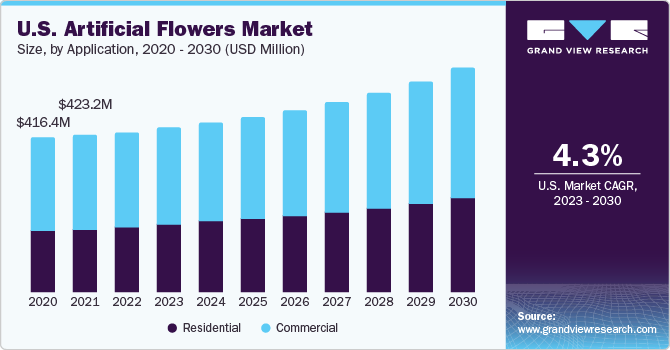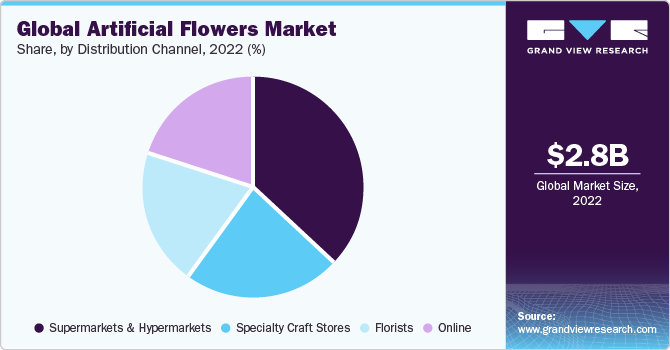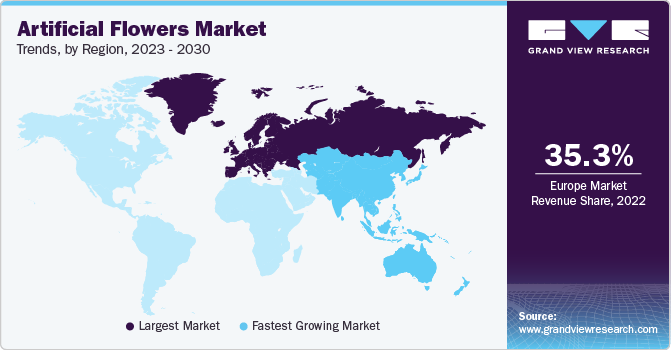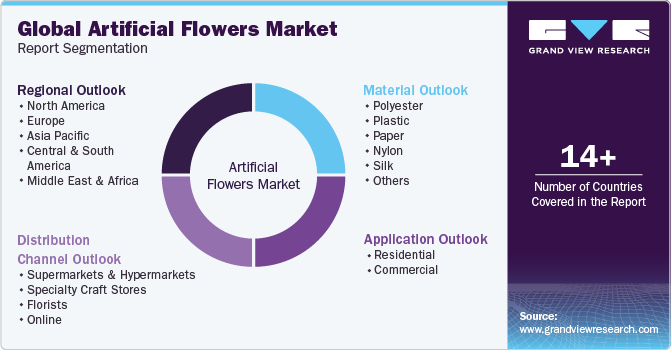- Home
- »
- Homecare & Decor
- »
-
Artificial Flowers Market Size, Share & Growth Report, 2030GVR Report cover
![Artificial Flowers Market Size, Share & Trends Report]()
Artificial Flowers Market Size, Share & Trends Analysis Report By Material (Polyester, Plastic, Paper, Nylon, Silk), By Application, By Distribution Channel (Supermarkets & Hypermarkets, Specialty Craft Stores), By Region, And Segment Forecasts, 2023 - 2030
- Report ID: GVR-4-68040-149-2
- Number of Report Pages: 100
- Format: PDF, Horizon Databook
- Historical Range: 2017 - 2021
- Forecast Period: 2023 - 2030
- Industry: Consumer Goods
Artificial Flowers Market Size & Trends
The global artificial flowers market size was estimated at USD 2.84 billion in 2022 and is expected to grow at a compound annual growth rate (CAGR) of 5.9% from 2023 to 2030. The market is driven by the rising demand for low-maintenance and long-lasting home décor items, especially in commercial spaces and households. The growing advancement in technology has led to the production of highly realistic and visually appealing artificial flowers, further driving the market growth. The availability of a wide variety of artificial flowers in different shapes, sizes, and colors, catering to diverse customer preferences, has contributed to market expansion. Furthermore, the growing trend of gifting artificial flowers for various occasions and events has also significantly contributed to the growing market demand.

The artificial flowers industry is experiencing a significant surge in popularity, driven by current home decor trends. In June 2022, Hobbycraft, an arts and crafts superstore retail chain in the UK reported that faux flowers have become a major trend, with a notable 8% increase in sales since last year. In October 2021, major retailers like Tesco and Amazon reported a significant increase in sales of artificial flowers, contributing to the market's growth. One of the key drivers is the cost-effectiveness and convenience of faux flowers, eliminating the need for frequent replacements and cleanup associated with real flowers. In addition, the trend is evolving beyond traditional vase displays, with an emerging focus on incorporating artificial flowers into creative arrangements like wreaths.
The artificial flowers industry is experiencing significant growth driven by innovations such as real-touch polyether polyurethane (PU) foam technology. Historically, artificial flowers were perceived as cheap and low quality. However, advancements in manufacturing processes and materials have led to the creation of high-quality, realistic artificial flowers that closely resemble real ones. These real-touch flowers, especially those made from PU foam, offer benefits such as low maintenance, durability, and vibrant colors, making them ideal for commercial spaces like offices, hotels, spas and salons, and retail stores. Their longevity, cost-effectiveness, and customization options have driven their adoption in various settings, contributing to the overall growth of the market.
Material Insights
Based on material, the polyester segment contributed to a revenue share of 33.98% in 2022 and is expected to maintain its lead over the forecast period. This is mainly attributed to the high degree of versatility and durability offered by polyester making it an ideal choice to manufacture realistic and long-lasting artificial flowers.Its ability to hold vibrant colors and intricate details enhances the visual appeal of polyester flowers. In addition, manufacturing artificial flowers from polyester fabric is cheaper than materials such as silk, which is driving its increased popularity and demand.
The silk flowers segment accounted for a revenue share of 11.97% in 2022. The market has a rich history rooted in ancient Chinese silk-making techniques. Initially crafted from silk, artificial flowers gained prominence when Italian and French artisans started creating faux blooms using silkworm cocoons. With the evolution in materials and technological advancements in manufacturing processes, polyester, and plastic have become the preferred material choices for the production of artificial flowers.
The paper segment is anticipated to witness a CAGR of 7.4% during the forecast period. This is mainly attributed to paper being a sustainable alternative to materials such as polyester and plastic, aligning with the increasing environmental consciousness among consumers. Furthermore, advancements in paper manufacturing technology have led to the creation of highly realistic and visually appealing artificial flowers, enhancing their appeal. The affordability of paper as a raw material also makes these artificial flowers cost-effective, and appealing to budget-conscious consumers. In addition, the growing trend of DIY (Do-It-Yourself) crafts and home decor projects has boosted the demand for paper-based artificial flowers, driving the market growth.
Application Insights
Based on application, the commercial segment accounted for a revenue share of 58.89% in 2022.In commercial settings, there has been a shift in demand from plastic to textile-based products. Textile materials are preferred for their versatility in design, color options, and ecological appeal. Artificial flowers and plants are now referred to as "semi-natural" and closely follow fresh flower trends in terms of species, colors, and popular varieties. Carnations, chrysanthemums, and roses are top choices for artificial flowers. The rental business, including exhibitions, offices, and special events like weddings, drives significant demand for artificial flowers and plants. Rental companies predominantly use "silk polyester" products due to their washable nature, colorfastness, and shape retention. This shift towards textile-based artificial flowers in commercial applications reflects the changing preferences and ecological considerations of consumers in the market.
The residential segment is projected to witness a CAGR of 6.4% during the forecast period.This is primarily attributed to artificial flowers requiring minimal maintenance, eliminating the need for watering, sunlight, and regular replacements, making them convenient for modern homeowners. In addition, they provide a long-lasting decorative solution, enhancing the aesthetic appeal of houses without the concerns of seasonal availability. The availability of a wide variety of designs and colors in artificial flowers also allows homeowners to customize their decor according to their preferences, further driving the demand for these products in residential settings.
Distribution Channel Insights
Based on distribution channel, the supermarkets and hypermarkets segment accounted for a revenue share of 37.10% in 2022. This is attributed to the large retail outlets offering a wide variety of artificial flower options, making it convenient for consumers to explore and choose their preferred items. The one-stop shopping experience provided by supermarkets and hypermarkets caters to customers looking for home decor and floral arrangements, resulting in increased sales. Furthermore, promotional activities and seasonal displays in supermarkets and hypermarkets create awareness and drive the demand for artificial flowers among consumers.

The online segment is expected to experience a CAGR of 6.9% during the forecast period owing to online platforms offering a wide variety of artificial flower options from the convenience of home. The growing internet penetration has further contributed to the growth of the online sales channel segment. Furthermore, online stores are expanding their collection of artificial flowers. For instance, in December 2019, Bloomist, an online store founded by Michael Zung and Alex Bates, introduced an eco-minded collection of faux flowers that challenge traditional perceptions of fake flowers. These artificial pieces, characterized by their artful design and eco-friendly materials, are part of Bloomist's effort to replace petroleum-based plastics with upcycled fabrics and recycled materials. The store's approach aligns with the growing consumer demand for sustainable and aesthetically pleasing artificial flowers.
Regional Insights
Europe accounted for a substantial revenue share of 35.34% in 2022 owing to a growing trend in incorporating artificial flowers in various commercial and residential applications. The region’s robust tourism and hospitality industry demands visually appealing and long-lasting decorative elements, driving the commercial use of artificial flowers in hotels, restaurants, and event venues.Europe's strong tradition of floral aesthetics and design appreciation has created a market for high-quality, realistic artificial flowers. In addition, as there is a shift towards sustainable materials in European countries, manufacturers in the region are focused on innovative designs and eco-friendly materials for manufacturing artificial flowers.

Asia Pacific is anticipated to witness a CAGR of 7.0% from 2023 to 2030. The region's booming commercial sector, including hospitality, events, and retail, has driven the demand for aesthetically pleasing and low-maintenance decor, boosting the market. In addition, the increasing disposable income in many Asian countries has led to higher consumer spending on luxury and decorative items, including artificial flowers. The rise of online platforms and e-commerce in the region has also made artificial flowers more accessible to a broader customer base, further driving sales.
Key Companies & Market Share Insights
The market is fragmented and is characterized by the presence of a large number of unorganized players in the market.Key companies in the market are focused on creating the most realistic botanical reproductions. Key participants have adopted new product launches, product portfolio expansion, and collaborations as key strategies to gain a competitive edge in the market. Companies such as New Growth Designs, a leading company in the artificial flowers industry manufacture luxury artificial floral designs with meticulous attention to detail. The company is focused on innovation and addressing challenges in the fresh floral industry and caters to the growing demand for high-quality artificial flowers in both residential and commercial sectors. The company's achievements are reflected in its presence in luxury stores, museums, and hotels worldwide, highlighting the increasing demand for premium artificial floral arrangements.
In February 2021, Diane James Home, a faux floral brand, collaborated with aerial photographer Gray Malin to create a collection of realistic artificial flower arrangements. These florals are highly realistic, long-lasting, and low maintenance for households. The growing preference for realistic and aesthetically pleasing artificial flowers has led to such collaborations to cater to the demand for convenience, longevity, and ability to elevate home decor.
Key Artificial Flowers Companies:
- TreeLocate (Europe) Limited
- Foshan Tongxin Artificial Flowers Co., Ltd
- Dongguan Fusheng Arts Products Co., Ltd.
- NGAR TAT PRODUCTION FTY. LTD.
- Oriental Fine Art Co., Ltd.
- Silk Flower
- Diane James Designs, Inc.
- J. S. Flower Company Limited
- Nearly Natural
- Floral Home Décor
Artificial Flowers Market Report Scope
Report Attribute
Details
Market size value in 2023
USD 2.95 billion
Revenue forecast in 2030
USD 4.50 billion
Growth rate
CAGR of 5.9% from 2023 to 2030
Base year for estimation
2022
Historical data
2017 - 2021
Forecast period
2023 - 2030
Quantitative units
Revenue in USD million/billion, and CAGR from 2023 to 2030
Report coverage
Revenue forecast, company ranking, competitive landscape, growth factors, and trends
Segments covered
Material, application, distribution channel, region
Regional scope
North America; Europe; Asia Pacific; Central & South America; Middle East & Africa
Country scope
U.S.; Canada; Mexico; Germany; UK; France; Italy; Spain; China; Japan; India; Australia; Brazil; South Africa; UAE
Key companies profiled
TreeLocate (Europe) Limited; Foshan Tongxin Artificial Flowers Co., Ltd; Dongguan Fusheng Arts Products Co. Ltd.; NGAR TAT PRODUCTION FTY. LTD.; Oriental Fine Art Co., Ltd.; Silk Flower; Diane James Designs, Inc.; J. S. Flower Company Limited; Nearly Natural; Floral Home Décor
Customization scope
Free report customization (equivalent up to 8 analysts working days) with purchase. Addition or alteration to country, regional & segment scope.
Pricing and purchase options
Avail customized purchase options to meet your exact research needs. Explore purchase options
Global Artificial Flowers Market Report Segmentation
This report forecasts revenue growth at global, regional & country levels and provides an analysis of the latest trends and opportunities in each of the sub-segments from 2017 to 2030. For this study, Grand View Research has segmented the global artificial flowers market report based on material, application, distribution channel, and region:

-
Material Outlook (Revenue, USD Million, 2017 - 2030)
-
Polyester
-
Plastic
-
Paper
-
Nylon
-
Silk
-
Others
-
-
Application Outlook (Revenue, USD Million, 2017 - 2030)
-
Residential
-
Commercial
-
-
Distribution Channel Outlook (Revenue, USD Million, 2017 - 2030)
-
Supermarkets & Hypermarkets
-
Specialty Craft Stores
-
Florists
-
Online
-
-
Regional Outlook (Revenue, USD Million, 2017 - 2030)
-
North America
-
U.S.
-
Canada
-
Mexico
-
-
Europe
-
Germany
-
UK
-
France
-
Italy
-
Spain
-
-
Asia Pacific
-
China
-
Japan
-
India
-
Australia
-
-
Central & South America
-
Brazil
-
-
Middle East & Africa
-
South Africa
-
UAE
-
-
Frequently Asked Questions About This Report
b. The global artificial flowers market was estimated at USD 2.84 billion in 2022 and is expected to reach USD 2.95 billion in 2023.
b. The global artificial flowers market is expected to grow at a compound annual growth rate of 5.9% from 2023 to 2030 to reach USD 4.50 billion by 2030.
b. Europe dominated the artificial flowers market with a share of 35.3% in 2022. The growth of the regional market is driven on account of the robust tourism and growing hospitality sector driving the demand for low-maintenance decor items.
b. Some of the key players operating in the artificial flowers market include TreeLocate (Europe) Limited, Diane James Designs, Inc., Nearly Natural, Dongguan Fusheng Arts Products Co., Ltd., Floral Home Décor, Silk Flower, and Oriental Fine Art Co., Ltd.
b. Key factors that are driving the artificial flowers market growth include rising demand for low-maintenance and long-lasting home décor items and the growing trend of gifting artificial flowers for various occasions and events.
Share this report with your colleague or friend.
![gvr icn]()
NEED A CUSTOM REPORT?
We can customize every report - free of charge - including purchasing stand-alone sections or country-level reports, as well as offer affordable discounts for start-ups & universities. Contact us now
![Certified Icon]()
We are GDPR and CCPA compliant! Your transaction & personal information is safe and secure. For more details, please read our privacy policy.
We are committed towards customer satisfaction, and quality service.
"The quality of research they have done for us has been excellent."





